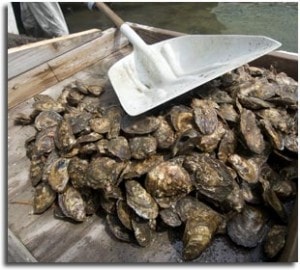
With the Obama Administration’s Executive Order to clean-up the Chesapeake Bay, the Chesapeake Bay Blueprint’s multi-step plan for doing so, and an alphabet soup of technical terms for controlling pollution – TMDLs, CREP, BOD, N loads, P levels and more – much of the Bay’s cleanup focuses on taking things out of it: Reducing the amount of nitrogen and phosphorus entering waterways stopping sediment runoff, using less fertilizer, and cutting air pollution from cars and power plants. But researchers at the National Oceanic and Atmospheric Administration (NOAA) and the U.S. Geological Survey (USGS) recently reminded us that sometimes you have to put something back into damaged ecosystems in order to heal them. In this case, that critical ingredient is oysters.
In a scientific paper published in the journal Aquatic Geochemistry last week, government researchers reported that all of the nitrogen currently polluting the Potomac River estuary could be eliminated if 40 percent of the river bed was devoted to oysters. This shouldn’t be a big surprise to those who know the human history of the Chesapeake Bay and the natural history of oysters. When Europeans settled the Bay region more than 300 years ago, the oyster reefs were so extensive they hampered navigation. Captain John Smith, exploring the area in 1608, was reported to have said that the oysters “lay as thick as stones.”
All those oysters did what oysters do best (beyond being delicious): they filtered the water. Oysters suck in seawater to trap algae for food. As they pump water through their gills, they also trap excess sediment, nutrients and other contaminants, keeping the water clean and clear for other creatures. (You can see a video of oysters filtering water here).
Long ago, when thick beds of oysters covered the bay floor, they cleansed the entire Bay every week; now it takes more than a year for their remaining descendants to filter that volume. Over the centuries, oyster reefs were destroyed by overharvesting, excessive sediment runoff from surrounding development, and disease. The population has declined to only 1% of what it once was, while nutrient pollution has skyrocketed. That combination has been a recipe for disaster.
So how do we mimic the natural formula that worked so well for centuries? The NOAA and USGS researchers recommended enhancing shellfish aquaculture – essentially seeding and harvesting oysters in ‘farms” for commercial sale — and restoring natural oyster reefs, to complement land-based strategies for reducing pollution. They note that, although it’s unlikely that 40 percent of the river bed would convert to oyster beds, even smaller coverage – say 15 to 20 percent – could eliminate half of the nitrogen entering the river. Right now, that vision is a long way away. But Maryland has taken the necessary first steps: it approved its Maryland Shellfish Aquaculture Plan in 2009 to promote private oyster operations throughout Bay estuaries, and is accepting applications from would-be oyster farmers to start new operations. With time, and the right combination of ingredients, the results could be not only environmentally healthy, but mighty tasty as well.


One thought on “The not-so-secret ingredient: Just add oysters”